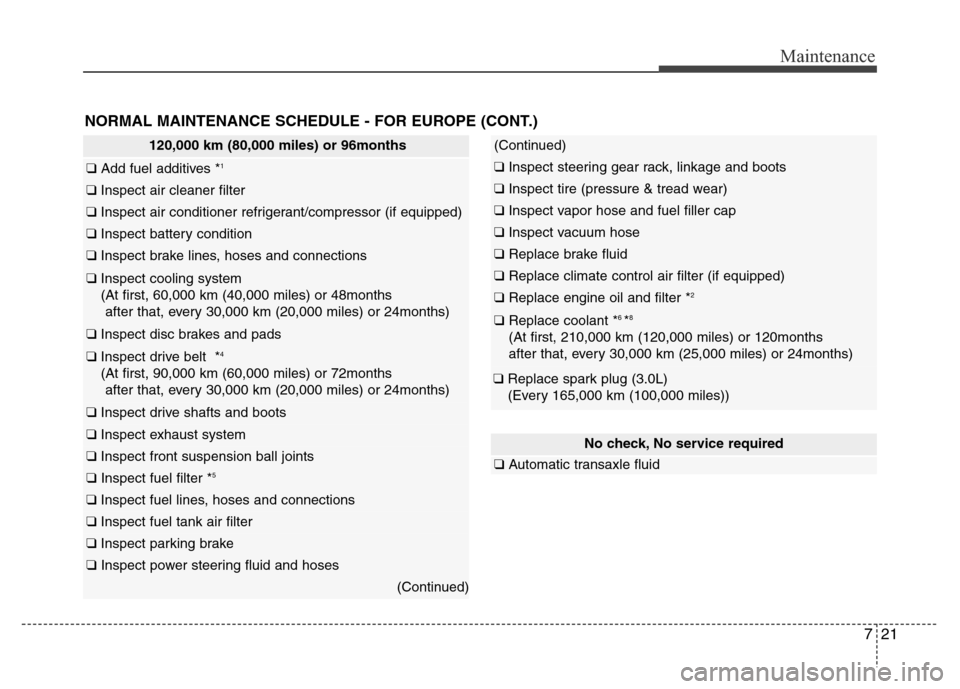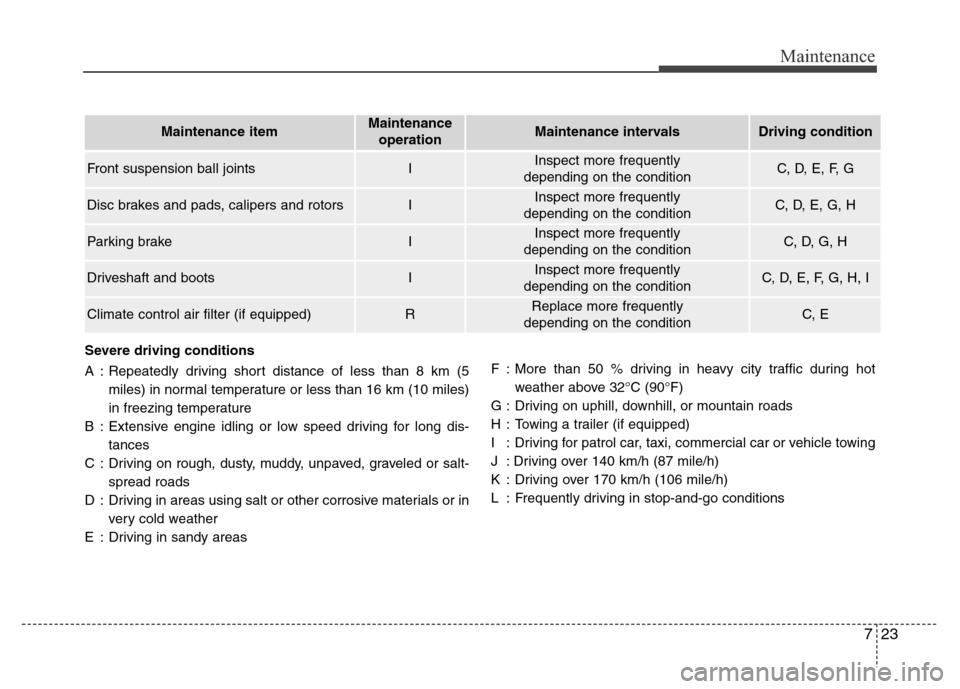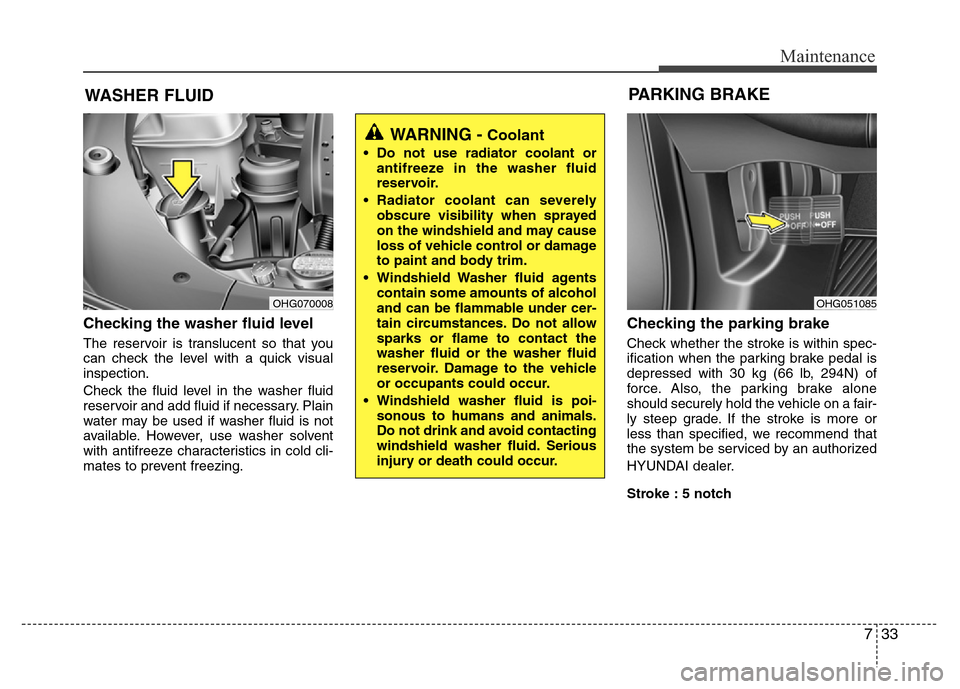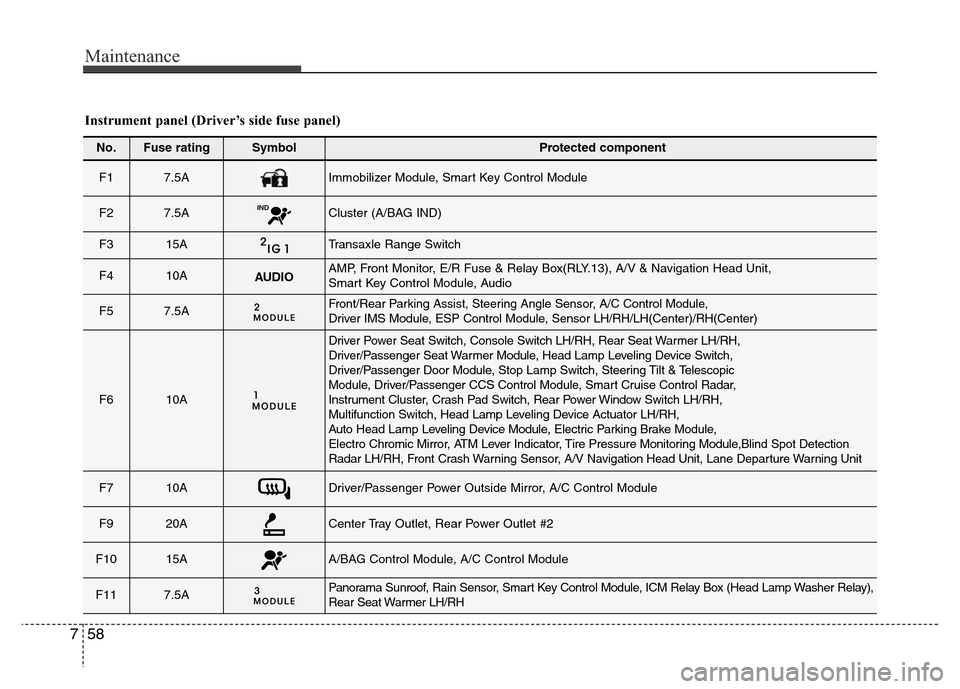Page 403 of 473

721
Maintenance
NORMAL MAINTENANCE SCHEDULE - FOR EUROPE (CONT.)
120,000 km (80,000 miles) or 96months
❑ Add fuel additives *1
❑ Inspect air cleaner filter
❑ Inspect air conditioner refrigerant/compressor (if equipped)
❑ Inspect battery condition
❑ Inspect brake lines, hoses and connections
❑ Inspect cooling system
(At first, 60,000 km (40,000 miles) or 48months
after that, every 30,000 km (20,000 miles) or 24months)
❑ Inspect disc brakes and pads
❑ Inspect drive belt *4
(At first, 90,000 km (60,000 miles) or 72months
after that, every 30,000 km (20,000 miles) or 24months)
❑ Inspect drive shafts and boots
❑ Inspect exhaust system
❑ Inspect front suspension ball joints
❑ Inspect fuel filter *5
❑ Inspect fuel lines, hoses and connections
❑ Inspect fuel tank air filter
❑ Inspect parking brake
❑ Inspect power steering fluid and hoses
(Continued)
(Continued)
❑ Inspect steering gear rack, linkage and boots
❑ Inspect tire (pressure & tread wear)
❑ Inspect vapor hose and fuel filler cap
❑ Inspect vacuum hose
❑ Replace brake fluid
❑ Replace climate control air filter (if equipped)
❑ Replace engine oil and filter *2
❑ Replace coolant *6 *8
(At first, 210,000 km (120,000 miles) or 120months
after that, every 30,000 km (25,000 miles) or 24months)
❑ Replace spark plug (3.0L)
(Every 165,000 km (100,000 miles))
No check, No service required
❑Automatic transaxle fluid
Page 405 of 473

723
Maintenance
Severe driving conditions
A : Repeatedly driving short distance of less than 8 km (5
miles) in normal temperature or less than 16 km (10 miles)
in freezing temperature
B : Extensive engine idling or low speed driving for long dis-
tances
C : Driving on rough, dusty, muddy, unpaved, graveled or salt-
spread roads
D : Driving in areas using salt or other corrosive materials or in
very cold weather
E : Driving in sandy areasF : More than 50 % driving in heavy city traffic during hot
weather above 32°C (90°F)
G : Driving on uphill, downhill, or mountain roads
H : Towing a trailer (if equipped)
I : Driving for patrol car, taxi, commercial car or vehicle towing
J : Driving over 140 km/h (87 mile/h)
K : Driving over 170 km/h (106 mile/h)
L : Frequently driving in stop-and-go conditions
Maintenance itemMaintenance
operationMaintenance intervalsDriving condition
Front suspension ball jointsIInspect more frequently
depending on the conditionC, D, E, F, G
Disc brakes and pads, calipers and rotorsIInspect more frequently
depending on the conditionC, D, E, G, H
Parking brakeIInspect more frequently
depending on the conditionC, D, G, H
Driveshaft and bootsIInspect more frequently
depending on the conditionC, D, E, F, G, H, I
Climate control air filter (if equipped)RReplace more frequently
depending on the conditionC, E
Page 408 of 473

Maintenance
26 7
Brake hoses and lines
Visually check for proper installation,
chafing, cracks, deterioration and any
leakage. Replace any deteriorated or
damaged parts immediately.
Brake fluid
Check brake fluid level in the brake fluid
reservoir. The level should be between
“MIN” and “MAX” marks on the side of
the reservoir. Use only hydraulic brake
fluid conforming to DOT 3 or DOT 4
specification.
Parking brake
Inspect the parking brake system includ-
ing the parking brake pedal or lever and
cables.
Brake discs, pads, calipers and
rotors
Check the pads for excessive wear, discs
for run out and wear, and calipers for fluid
leakage.
For more information on checking the
pads or lining wear limit, refer to the
Hyundai web site.
(http://brakeman
ual.hmc.co.kr)
Suspension mounting bolts
Check the suspension connections for
looseness or damage. Retighten to the
specified torque.
Steering gear box, linkage &
boots/lower arm ball joint
With the vehicle stopped and engine off,
check for excessive free-play in the
steering wheel.
Check the linkage for bends or damage.
Check the dust boots and ball joints for
deterioration, cracks, or damage.
Replace any damaged parts.
Power steering pump, belt and
hoses
Check the power steering pump and
hoses for leakage and damage. Replace
any damaged or leaking parts immedi-
ately. Inspect the power steering belt (or
drive belt) for evidence of cuts, cracks,
excessive wear, oiliness and proper ten-
sion. Replace or adjust it if necessary.
Drive shafts and boots
Check the drive shafts, boots and clamps
for cracks, deterioration, or damage.
Replace any damaged parts and, if nec-
essary, repack the grease.
Air conditioning refrigerant
(if equipped)
Check the air conditioning lines and con-
nections for leakage and damage.
Page 415 of 473

733
Maintenance
WASHER FLUID
Checking the washer fluid level
The reservoir is translucent so that you
can check the level with a quick visual
inspection.
Check the fluid level in the washer fluid
reservoir and add fluid if necessary. Plain
water may be used if washer fluid is not
available. However, use washer solvent
with antifreeze characteristics in cold cli-
mates to prevent freezing.
Checking the parking brake
Check whether the stroke is within spec-
ification when the parking brake pedal is
depressed with 30 kg (66 lb, 294N) of
force. Also, the parking brake alone
should securely hold the vehicle on a fair-
ly steep grade. If the stroke is more or
less than specified, we recommend that
the system be serviced by an authorized
HYUNDAI dealer.
Stroke : 5 notch
WARNING -Coolant
• Do not use radiator coolant or
antifreeze in the washer fluid
reservoir.
• Radiator coolant can severely
obscure visibility when sprayed
on the windshield and may cause
loss of vehicle control or damage
to paint and body trim.
• Windshield Washer fluid agents
contain some amounts of alcohol
and can be flammable under cer-
tain circumstances. Do not allow
sparks or flame to contact the
washer fluid or the washer fluid
reservoir. Damage to the vehicle
or occupants could occur.
• Windshield washer fluid is poi-
sonous to humans and animals.
Do not drink and avoid contacting
windshield washer fluid. Serious
injury or death could occur.
OHG070008OHG051085
PARKING BRAKE
Page 440 of 473

Maintenance
58 7
Instrument panel (Driver’s side fuse panel)
No.Fuse ratingSymbol Protected component
F1 7.5AImmobilizer Module, Smart Key Control Module
F2 7.5A INDCluster (A/BAG IND)
F3 15ATransaxle Range Switch
F410AAUDIOAMP, Front Monitor, E/R Fuse & Relay Box(RLY.13), A/V & Navigation Head Unit,
Smart Key Control Module, Audio
F57.5AFront/Rear Parking Assist, Steering Angle Sensor, A/C Control Module,
Driver IMS Module, ESP Control Module, Sensor LH/RH/LH(Center)/RH(Center)
F610A
Driver Power Seat Switch, Console Switch LH/RH, Rear Seat Warmer LH/RH,
Driver/Passenger Seat Warmer Module, Head Lamp Leveling Device Switch,
Driver/Passenger Door Module, Stop Lamp Switch, Steering Tilt & Telescopic
Module, Driver/Passenger CCS Control Module, Smart Cruise Control Radar,
Instrument Cluster, Crash Pad Switch, Rear Power Window Switch LH/RH,
Multifunction Switch, Head Lamp Leveling Device Actuator LH/RH,
Auto Head Lamp Leveling Device Module, Electric Parking Brake Module,
Electro Chromic Mirror, ATM Lever Indicator, Tire Pressure Monitoring Module,Blind Spot Detection
Radar LH/RH, Front Crash Warning Sensor, A/V Navigation Head Unit, Lane Departure Warning Unit
F710ADriver/Passenger Power Outside Mirror, A/C Control Module
F920ACenter Tray Outlet, Rear Power Outlet #2
F1015AA/BAG Control Module, A/C Control Module
F117.5APanorama Sunroof, Rain Sensor, Smart Key Control Module, ICM Relay Box (Head Lamp Washer Relay),
Rear Seat Warmer LH/RH
Page 444 of 473
Maintenance
62 7
No.Fuse ratingSymbol Protected component
FUSE
F1425A-
F1530A2Electronic Parking Brake Module
F1640AIG 2RLY. 5 (Start Relay), W/O Smart Key - Ignition Switch,
With Smart Key - RLY. 10 (PDM 3 (IG2) Relay)
F1730A1Electronic Parking Brake Module
F1840A5EMS Block (Fuse - F36 / F37 / F38 / F39)
F1940A2ESC Control Module, ABS Control Module
F2050ARLY. 3 (C/Fan 2 Relay), RLY. 4 (C/Fan 1 Relay)
F2110APCM
F2320AMultipurpose Check Connector
F2410ABattery Sensor
F2510ASmart Cruise Control Radar
F2615ASTOP LAMPStop Signal Electronic Module
F2720AFRONTRLY. 7 (Deicer Relay)
Page 447 of 473

765
Maintenance
LIGHT BULBS
Use only the bulbs of the specified
wattage.
✽NOTICE
After driving in heavy rain or washing
the vehicle, headlight and taillight lenses
could appear frosty. This condition is
caused by the temperature difference
between the lamp inside and outside.
This is similar to the condensation on
your windows inside your vehicle during
the rain and doesn’t indicate a problem
with your vehicle. If the water leaks into
the lamp bulb circuitry, we recommend
that the system be checked by an author-
ized HYUNDAI dealer.
Headlight, position light, turn sig-
nal light, front fog light bulb
replacement
(1) Headlight (High)/DRL (Daytime rinning
light) (if equipped)
(2) Headlight (Low)
(3) Front turn signal light
(4) Position light
(5) Front fog light
WARNING - Working on
the lights
Prior to working on the light, firmly
apply the parking brake, ensure
that the ignition switch is turned to
the LOCK position and turn off the
lights to avoid sudden movement
of the vehicle and burning your fin-
gers or receiving an electric shock.
CAUTION
Be sure to replace the burned-out
bulb with one of the same wattage
rating. Otherwise, it may cause
damage to the fuse or electric
wiring system.
CAUTION
If you don’t have necessary tools,
the correct bulbs and the expertise,
we recommend that you consult an
authorized HYUNDAI dealer. In
many cases, it is difficult to replace
vehicle light bulbs because other
parts of the vehicle must be
removed before you can get to the
bulb. This is especially true if you
have to remove the headlight
assembly to get to the bulb(s).
Removing/installing the headlight
assembly can result in damage to
the vehicle.
OHG075025